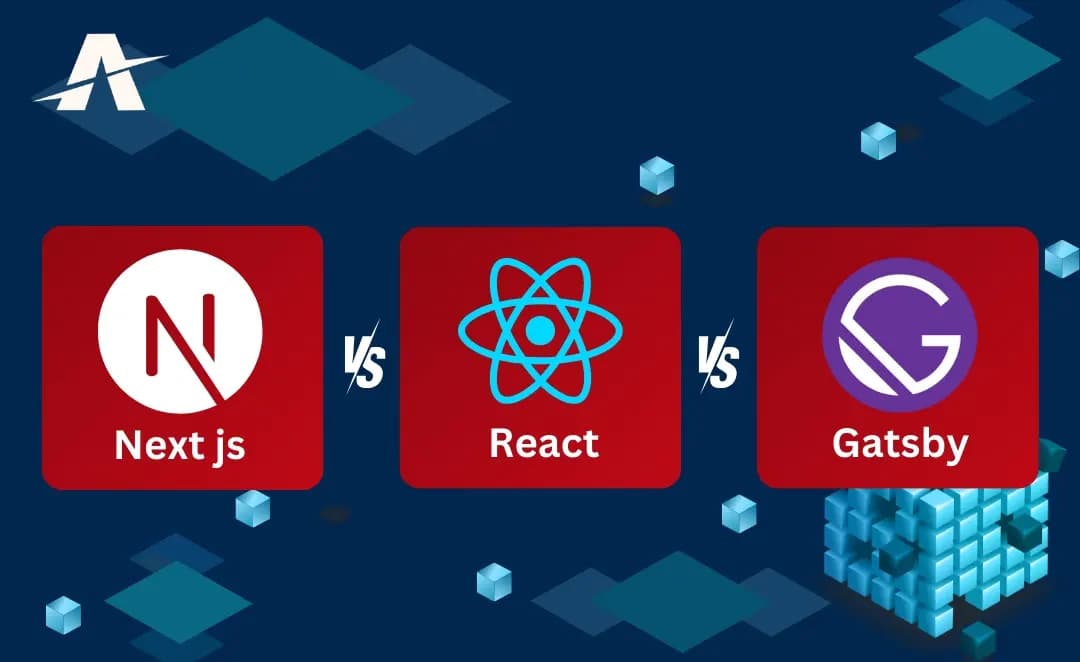Introduction
In the ever-evolving realm of web development, the choice between Next.js, React, and Gatsby can often leave developers perplexed. Each framework boasts unique strengths, empowering developers to craft tailored solutions for a wide range of applications. Let's unravel the intricacies of Next.js, React, and Gatsby, delving into their features, performance, and ideal use cases. Embark on this journey with us as we decipher the complexities of web development.
Discovering Next.js:
Next.js, a powerful React framework, goes beyond the traditional React library to provide server-side rendering, routing, and a host of other features out of the box. Its seamless integration with React makes it a preferred choice for building dynamic and performant web applications. But what sets Next.js apart from its sibling, React?
Decoding React:
React, born out of Facebook's ingenuity, is a declarative, efficient, and flexible JavaScript library for building user interfaces. It excels at creating interactive UI components, enabling developers to build single-page applications with ease. As a foundational library, React forms the base for frameworks like Next.js and Gatsby. Now, how does Gatsby fit into this narrative?
Gatsby Unveiled:
Gatsby, a static site generator powered by React, offers a different approach by focusing on creating fast, optimized websites. It excels in building static websites with dynamic capabilities, making it an excellent choice for content-driven projects. Now that we have a basic understanding of each, let's delve into a detailed comparison of their features.
Features of Next.js vs React vs Gatsby:
Table: Features Comparison
| Features | Next.js | React | Gatsby |
|---|---|---|---|
| Server-side Rendering | ✓ | - | - |
| Static Site Generation | ✓ | - | ✓ |
| Routing | ✓ | - | ✓ |
| Data Fetching | ✓ | - | ✓ |
| Plugin Ecosystem | - | - | ✓ |
| Performance | High | High | Very High |
Pros & Cons of Next.js vs React vs Gatsby:
Table: Pros & Cons
| Next.js | React | Gatsby | |
|---|---|---|---|
| Pros | - Powerful SSR and SSG capabilities | - Widely adopted in the industry | - Excellent performance for static sites |
- Robust routing system | - Large developer community | - Rich plugin ecosystem | |
- Seamless integration with React | - Reusable components | - Quick development with GraphQL | |
| Cons | - Learning curve for newcomers | - Lack of built-in routing | - May be overkill for simple projects |
- Limited built-in state management | - Boilerplate code for complex apps | - Learning curve for beginners |
Next JS vs React: Performance
When it comes to performance, both Next.js and React boast high efficiency. Next.js, with its built-in server-side rendering, excels in delivering fast-loading pages, especially beneficial for SEO.
Next JS vs Gatsby: Performance
Next.js and Gatsby both focus on performance, but the key difference lies in their approach. Next.js leans towards dynamic web applications with server-side rendering, while Gatsby's strength lies in generating highly optimized static sites.
React vs Gatsby: Performance
React, being the foundational library for both Next.js and Gatsby, offers excellent performance. However, Gatsby's emphasis on static site generation can lead to faster load times, making it a contender for certain use cases.
When to Use Next.js Over Gatsby & React
Choosing Next.js is ideal when you need server-side rendering for dynamic content, intricate routing, and a seamless integration with React for building robust web applications.
When to Use React Over Next.js & Gatsby
Opt for React when your project requires a flexible, component-based UI library and when you don't necessarily need the additional features provided by Next.js or Gatsby.
When to use Gatsby over Next.js & React
Gatsby shines when building content-centric websites, blogs, or projects where static site generation and excellent performance are paramount.
Intended Use Cases for Next.js, Gatsby, and React:
- Intended Use Cases for Next.js:
- Dynamic web applications with server-side rendering.
- Projects requiring a powerful routing system.
- Intended Use Cases for Gatsby:
- Content-driven websites, blogs, and portfolios.
- Projects emphasizing fast-loading static sites.
- Intended Use Cases for React:
- Building interactive and dynamic user interfaces.
- Developing single-page applications with a component-based architecture.
Is Next.js Better than Gatsby?
The answer depends on your project requirements. If you need dynamic content, server-side rendering, and a robust routing system, Next.js might be the better choice. However, if you prioritize static site generation and excellent performance for content-centric projects, Gatsby could be the preferred option.
In conclusion, understanding the nuances of Next.js, React, and Gatsby is crucial for making an informed decision in your web development journey. Each technology comes with its own strengths, and the key lies in aligning those strengths with your project requirements. Happy coding!













